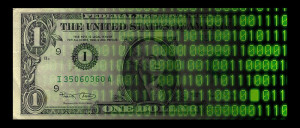By Ed McLaughlin and Wyn Lydecker
The recent collapse of Mt. Gox brought digital currency to the front pages of news outlets all over the world. Bitcoin was the first digital currency to gain enough traction to emerge from the all-nerd community into the public realm. It seemed like science fiction at first: a futuristic society with invisible credits that have no physical representations. Economists and futurists think it is just the first foray into a world of completely digital currency. “A Revolution in Money,” from the New York Times on April 1st paints a picture of a gloriously convenient world where shopping is as easy as walking into a store and then walking out. Computers will do the rest of the work of identifying you and transferring the right amount of money for what you take. It may seem like a leap, but we have already started taking steps in that direction. Someday soon, the wallet may be as outdated a symbol of money as the 3 1/2 inch floppy disk is of saving a file.
This is not the first news foray into digital transactions – back in November, NBC covered the boom in mobile money in Kenya in “Cashless Africa: Kenya’s Smash Success with Mobile Money.” More and more countries are getting on board. In “Tap to Pay: Not So Much in the US,” the New York Times talks about how countries like Sweden are embracing smartphones as a primary payment method. Apps like PopMoney, services like PayPal, and the new Coin card in the US are all strides toward a cashless world for buyers. They allow consumers to go out armed only with a smartphone or card (or case that combines them) and interact with the economy. The Square reader makes digital transactions possible for any vendor willing to pay 2.75% on each swipe. Even traditionally cash-only businesses, like farmers’ markets, are employing these digital methods.
Both mobile money and smartphone card readers mean changes for the way businesses deal with money. They also represent a fork in the road. Where should current startups place their bets? On progressively smarter cards, or more reliance on mobile phones? Over the long haul, I, personally, think we will move toward the smartphone. Smartphones are already integrated into most people’s lives. Plus, it’s easier to add money to a phone than phone functionality to a card. That said, I am prepared to be wrong. Isaac Asimov predicted the Multivac based on the tendencies of computer users and technology in his own time. It was completely reasonable, and turned out to be completely wrong. Where he was right, though, was in thinking computers would change the world. They have. Digital money is going to do the same thing. How can you make your business ready?
Ed McLaughlin is currently co-writing the book “The Purpose Is Profit: Secrets of a Successful Entrepreneur from Startup to Exit” with Wyn Lydecker and Paul McLaughlin.
Copyright © 2014 by Ed McLaughlin All rights reserved.





Leave A Comment